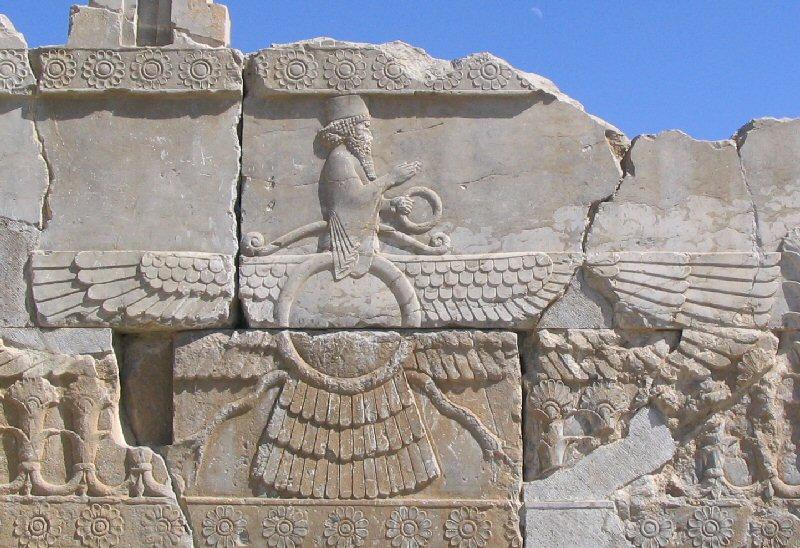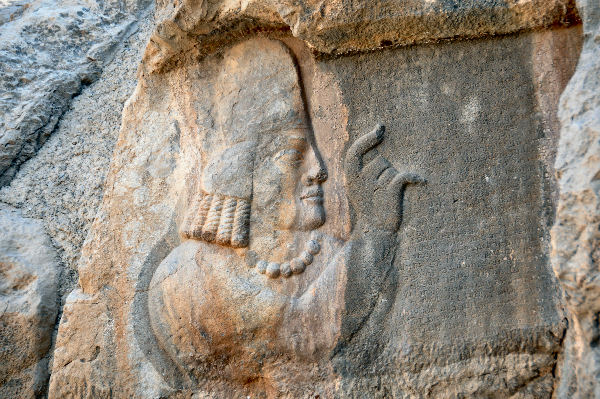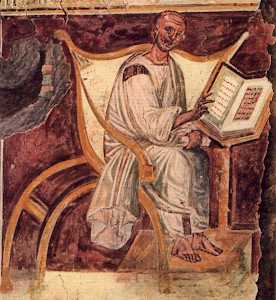Manicheism
Manicheism can be seen as the first synthesis of world religions. This may explain why this kind of dualism could become a world religion itself and spread itself in a brief time from the Atlantic to the Pacific Oceans.
Teachings
In the Manichean world view, a divine realm of Light opposes a realm of Darkness. It is, therefore, a purely dualistic world view. Both powers are engaged in a permanent struggle, in which light sparks, the spirits of human beings, have been "captured" by the dark, material world. The believer's aim is to liberate these captured parts, which means that the spirit has to be more powerful than the body.
When living creatures are killed, even when fruits are picked, the Light is wounded, and its captivity in this world prolonged. Procreation also contributes to the suffering of the Light's substance.
Manicheism's eschatology consists of a Last Judgment, in which Light and Darkness will be separated for good. The idea that Light will, in the end, be triumphant, means that Manichaeism is essentially a teaching of salvation.
Origin and Geography

A comparable dualistic world view can be found in Iranian Mazdaism, in which the good god Ahuramazda is opposed to the evil god Ahriman. This was the state cult of the Sasanian Empire, although it has antecedents that go back to Achaemenid times. The Behistun Inscription, in which king Darius the Great (r. 522-486) describes his victories, places the triumph of Ahuramazda in opposition to the defeat of The Lie.
Ideas like these influenced the prophet Mani, who was born in Ctesiphon in 214, called himself an apostle of Jesus Christ, and started to teach in Babylonia in c.240. Because he lived in the Sasanian Empire, some modern historians have denied his Christian affiliations, and stressed the Iranian background of his teachings. Mani, however, argued that Buddha, Zarathustra, Hermes Trismegistos, Plato, and Jesus Christ, all brought the message of the same God to mankind. He tried to merge the doctrines of these earlier teachers, stressing an ascetism that may have been influenced by Marcionite Gnosticism.

In 242, Mani was at the court of the Sasanian king Shapur I, to whom he dedicated one of his books. He traveled to Media, Turkestan, and Gandara, while his disciples went to Egypt, Syria, and Parthia. Mani's luck, however, ran out during the reign of Bahram I, who ordered his arrest in 276. He was tortured to death in Gund-e Shapur.
Because of the persecution, Mani's disciples fled to the east and west, which effectively contributed to the rise of the new religion. Within a century, there were Manichean churches from Central Asia to Carthage, and it was certainly possible that Manicheism, instead of Christianity, would become the leading world religion. In Turkestan, Manicheism was to have its most lasting influence. By the year 1000, it was still the most important religion in that area.

In Africa, Manicheism was less powerful, although between 373 and 382, Augustine, the future bishop of Hippo and father of the Church, was a Manichean. Later, he converted to Christianity and attacked his former religion in a treatise Against the Manicheans, which was, for centuries to come, the most important source about this religion. Augustine's authority made sure that in the Middle Ages, every dualistic belief was labeled Manichean.
However, the heart of Mani's religion was in western Asia, in Syria and what is now called Iraq. Here, Manicheism flourished in the tenth century, in spite of persecutions by Christians, Muslims, and Zoroastrians.
History
The facts of the history of Manicheism are hard to establish. In spite of its swift expansion, it seems that by the sixth century, it was already past its prime. In the harsh and often violent world of Late Antiquity, a religion that preached pacifism, objected to the killing of all living creatures, and inspired people to live ascetic lives, was bound to disappear. Its members were at times violently persecuted. Nevertheless, continued Christian and Islamic criticism proves that there were still Manicheans around.
As already indicated, because of Augustine's influence, the word "Manicheism" was used pejoratively by Christian authors to describe all kinds of dissident groups and heretics, although they were often not comparable. Paulicians, Marcionites, Zoroastrians and other Mazdaists - they have, at various times in history, all been likened to Manicheans. In the High Middle Ages, heterodox believers like the Bogomils, Cathars, and Waldensians were attacked with this standard accusation, which has been refuted by recent scholarship.
Sources
Our main sources are Christian anti-Manichean treatises, like Augustine's Against the Manicheans, Ephrem the Syrian, and Epiphanius of Salamis, or the edict that started Diocletian's persecution. There are also several Islamic authors.
However, there are also several original Manichean texts, which have been discovered in 1902-1914 in Turkestan and are still not fully published. Other original writings include the Tebessa Codex, and the Kölner Mani-Codex, which measures only 3.5 x 4.5 cm, and is written in extremely fine letters, and contains a text named On the Origin of His Body. A very large library, dating to c.400 CE, was found in Medinet Madi; now in Dublin, it contains homilies, a psalm book, a book called Synaxeis, and The Kephalaia of the Wisdom of Lord Mani. The psalm book is the largest surviving book from the ancient world.